.
Griechische Wissenschaftler
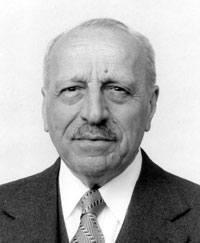
George N. Papanicolaou was a Greek physician and anatomist in the United States (1883 - 1962). Papanicolaou is the discoverer of "Pap Smear" or "Papanicolaou Smear", a life saving test, saving millions of lives of women around the world by early detecting the cancer of the cervix of uterus and other premalignant conditions of the female genital tract.
Papanicolaou was born in Kymi/Euboea, Greece, in 1883, son of Nicholas Papanicolaou, a physician, and Maria, a cultured lady with a love for the classics. He had one brother and two sisters. He attended school in Athens from the age of 11, and in 1898 entered the University of Athens to study humanities and music. However, complying with his father's wish, he continued his studies at the medical faculty of the University in Athens where he received his medical degree in 1904. Against his father's advice, the younger Dr Papanicolaou embarked upon an academic career, earning a PhD in zoology from the University of Munich in 1910.
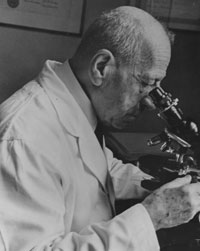
In 1912, while working in Paris, the first world war broke out and he returned to Greece with his wife to fight for his country's. He met some Greek-Americans there, who suggested him to go to America, which he did the following year. In 1913, Dr. Papanicolaou arrived in America with Mary, his new wife and lifelong research associate, becoming an assistant and research biologist under Charles R. Stockard, MD, at Cornell Medical College, where he was to stay for 47 years. Drs. Stockard and Papanicolaou studied the role of chromosomes in sex determination, and Dr. Papanicolaou noticed recurring cytological changes over a 15 to16-day cycle, in the vaginal discharge of the guinea pig. By correlating these changes with the ovarian and uterine cycles, the scientists described a technique that in time became standard for measuring the sexual cycles in a variety of species. Dr. Papanicolaou discovered that women with uterine cancer exhibited "abnormal cells, with enlarged, deformed, or hyperchromatic nuclei." He termed it, "One of the most thrilling experiences in my scientific career," but the scientific community considered Dr. Papanicolaou's technique an unnecessary addition to existing uterine cancer diagnosis.
When, in 1928, he published one paper "New detection of cancer", he was being treated as 'story-teller' by the medical nomenclature of that time. However, the newspaper "New York World" thought that, even that his paper could not predict how useful his method would be, cancer would have to be dealt with, in its earlier stages, and so a possible cure would, anyway, become easier.
Dr. Papanicolaou joined Herbert F. Traut, a gynecologist who appreciated the importance of his research, in 1939. They showed in a publication how lesions could be detected in their incipient, preinvasive phase and was a turning point in management of cervical cancer, the most deadly form of cancer in women at the time. The Pap smear test soon became widely accepted as a routine screening technique and in two decades, cervical cancer went from first to third most deadly form of cancer. In the following years, Dr. Papanicolaou extended his technique to the respiratory, urinary, and upper gastrointestinal tracts and the breast. His method has been used to screen for cancer in many organs and to predict cancer radiosensitivity and evaluate the efficacy of radiotherapy.
Exfoliated cytology, and "Dr. Pap," attracted worldwide attention. Honors and invitations came from numerous institutions and organizations -- including the American Society of Clinical Pathologists, which invited him to present the opening paper for a symposium on "Cytologic Diagnosis of Cancer" at the twenty-seventh annual meeting in 1948. He became an honorary ASCP Fellow in 1956.
Throughout his career Dr. Papanicolaou's work habits and character remained constant. A devoted scientist, he worked six or seven days a week with no vacations for years. He operated with great care and thoroughness, which may have contributed to a somewhat trying secretive streak. Yet he remained a courtly man who treated his achievements lightly, "I often feel that whatever I have accomplished has been largely a matter of good luck." Although Dr. Papanicolaou was not a very enthusiastic teacher, he was proud of his Atlas of Exfoliative Cytology, a textbook that was published in 1954 with supplements in 1957 and 1960. Toward the end of his life he dreamed of an institute for exfoliative cytology, desiring a less constrained research environment where future scientists and technicians could be trained. In 1961 he became director of the Papanicolaou Cancer Research Institute in Miami; but the dream was short-lived. Months after moving to Florida, on February 1962, Dr. Papanicolaou died of a heart attack and pulmonary edema at age 79 and is buried in New Jersey.

Numismatic item: A 10000 drachma bill of Greece honoring Dr. Papanicolaou. Now Drachmas have been replaced by the Euro.
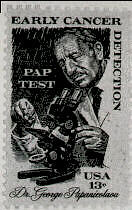
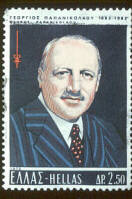
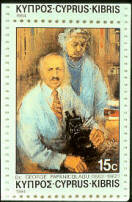
Stamps from USA, Greece and Cyprus of George N. Papanicolaou, father of cervical cancer screening by cytology, the Pap test. The USA stamp commemorates the 100th anniversary of his birthday.
(Stamps of Papanicolaou: 1 2 3 4 5 )
Dr. Papanicolaou authored over 150 publications, and throughout his life he received 53 awards and various many honors. He was a candidate for the Nobel Prize in Medicine but did not receive it even if millions of women have received the Pap test and deaths from cancer of uterus has been greatly reduced because of the test. It was predominantly through Dr. Papanicolaou’s efforts that cytology became accepted as a basis for diagnosis.
Quotations
After all it was here that he dreamed of living and working, remarks of the wife of Papanicolaou after she did not accept the request of the Greek government Papanicolaou to be buried in Greece.
References
G. N. Papanicolaou: New cancer diagnosis. Proceedings of the Third Race Betterment Conference, January 1928. Race Betterment Foundation, Battle Creek, Michigan, 1928: 528-534.
G. N. Papanicolaou and H. F. Traut: The diagnostic value of vaginal smears in carcinoma of the uterus. American Journal of Obstetrics and Gynecology, St. Louis, 1941, 42: 193-206.
G. N. Papanicolaou and Herbert Frederick Traut: Diagnosis of uterine cancer by the vagina smear. Commonwealth Fund, New York, 1943.
Links
http://www.papsociety.org/drpap.html The Papanicolaou Society of Cytopathology
http://www.teslasociety.com/index.html The Tesla Society
http://www.new-byzantium.org/orderofs.html
( Ta NEA in Greek)
| Ancient Greece
Science, Technology , Medicine , Warfare, , Biographies , Life , Cities/Places/Maps , Arts , Literature , Philosophy ,Olympics, Mythology , History , Images Medieval Greece / Byzantine Empire Science, Technology, Arts, , Warfare , Literature, Biographies, Icons, History Modern Greece Cities, Islands, Regions, Fauna/Flora ,Biographies , History , Warfare, Science/Technology, Literature, Music , Arts , Film/Actors , Sport , Fashion --- |

